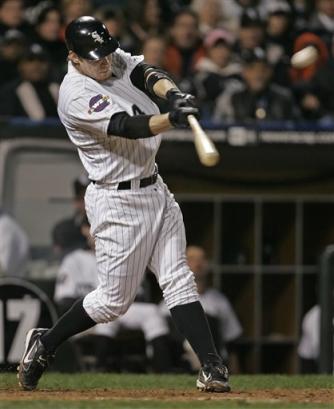 New general manager Chris Getz put his first stamp on the White Sox organization yesterday, declining the team’s $14 million option on Tim Anderson’s contract for 2024, making him a free agent. Anderson, who was arguably the face of the franchise, saw his fortunes fall in the second half of 2022 and continued to freefall in 2023.
New general manager Chris Getz put his first stamp on the White Sox organization yesterday, declining the team’s $14 million option on Tim Anderson’s contract for 2024, making him a free agent. Anderson, who was arguably the face of the franchise, saw his fortunes fall in the second half of 2022 and continued to freefall in 2023.
Drafter by the White Sox in the first round in 2013, Tim Anderson made his major league debut on June 10, 2016, going 2-3 in a victory against the Royals at US Cellular Field. Replacing veteran Jimmy Rollins, who would be released five days later, Anderson played 99 games, hitting .283 with nine home runs, and finished seventh in Rookie of the Year balloting. Showing that he was still a work in progress, Anderson slashed .257/.276/.402 in 2017, with a 2.1% walk rate, the lowest in the major leagues. Defensively, he led the major leagues in errors, with 28, as well as fielding errors (16) and throwing errors (12). He showed slight improvements in 2018, with slight improvements in his OBP and slugging percentage, while reducing his overall errors.
2019 was Anderson’s coming out party. He led the major leagues with a .335 average while raising his OPS to .865, setting career highs with 167 hits, 32 doubles, and 81 runs. He still had some issues on defense, leading all major league players with 26 errors, leading to the lowest fielding percentage amongst all shortstops. His hot bat continued into the pandemic-shortened 2020 season, notching a .322 average and an .886 OPS. He won his first Silver Slugger award while leading the White Sox to their first post-season appearance since 2008. He thrived in the Wild Card series against the A’s, going 9-14 in the three-game series.
Anderson continued to prove that he his offensive improvement wasn’t a fluke when baseball returned full time in 2021. He was named to his first All Star team and, on the game’s biggest stage, he hit a walk-off home run against the Yankees in the inaugural Field of Dreams game in the cornfields of Iowa. Overall, he hit .309 and posted an .807 OPS while hitting 17 home runs and driving in 61 RBIs. Continuing where he left off the previous October, Anderson hit .368 in the ALDS against the Astros.
Things started to sour for Anderson in 2022, both on the field and off. Injuries limited him to just 79 games and left him with his lowest OPS since 2018. Off the field, an Instagram post by a woman who was not Anderson’s wife insinuated they were in a relationship, and he was the father of her unborn child. Looking for a fresh start, Anderson played with Team USA in the 2023 World Baseball Classic, earning praise from manager Mark DeRose and outfielder Mike Trout. Unfortunately, those good vibes did not spill over to the 2023 season. After an early injury, Anderson struggled the entire year, his OPS dropped to a career-low .582 and he managed just a single home run.
Now Anderson will look to rebuild his career outside of the only franchise he has ever known while the White Sox look to find a stopgap shortstop for 2024 until 2021 first round draft pick Colson Montgomery is ready to take the reins.
Anderson’s numbers in a White Sox uniform, both for games I attended and overall, were:
 Last
Last 
 After winning a Wild Card slot in 2020 and running away with the Central Division title in 2021, the White Sox looked like an easy lock to make a third straight post-season appearance this October. Unfortunately, something (or somethings) went wrong along the way and after a long season where nothing ever seemed to click, the team was officially eliminated on Sunday after dropping six straight against the Guardians and the Tigers. So where did things fall apart? Let’s take a deeper look.
After winning a Wild Card slot in 2020 and running away with the Central Division title in 2021, the White Sox looked like an easy lock to make a third straight post-season appearance this October. Unfortunately, something (or somethings) went wrong along the way and after a long season where nothing ever seemed to click, the team was officially eliminated on Sunday after dropping six straight against the Guardians and the Tigers. So where did things fall apart? Let’s take a deeper look.





